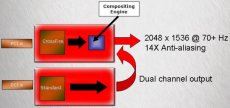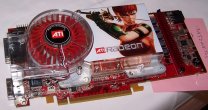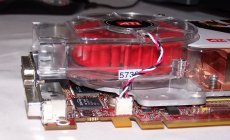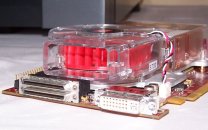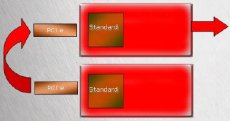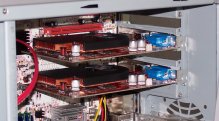X1000 Crossfire Support
Despite the fundamental performance increases, given the lateness of its introduction and the resolution limitation, ATI's dual graphics "Crossfire" solution garnered a fairly cold response with X850. However they are continuing with the Crossfire solution on the new X1000 series, keeping some elements, such as the external connection, but removing others, such as the current resolution limitation. Although ATI are not actually introducing X1000 Crossfire just yet they have outlined the support already, and in this instance there is actually a two tiered implementation.
The top tier, occupied by X1800 and X1600 Crossfire solutions, features a similar board implementation as X850 Crossfire, with X1800 and X1600 Crossfire Edition "master" boards that can be paired with standard X1800 and X1600 boards respectively. This solution does still mean that vendors will have to carry two boards types and there is less options for getting the optimal configuration for the particular boards that you may have. However, with this solution ATI have addressed the resolution limitation by virtue of the fact that all of the X1800 and X1600 boards have integrated dual DVI, which means the slaves can output dual DVI bandwidths and the composite engine can be built to cope with this, outputting back at dual DVI rates - the net result is that this generation of Crossfire can support resolutions up to 2048x1536 @ 85Hz. For this Crossfire generation, the Super AA modes have also been programmed to use the composite engine, rather than going across the PCI Express bus, which should result in a performance boost for Super AA. ATI also point out that the compositing engine is software programmable, so its operation and tasks can be altered with new driver revisions.
The early X1800 Crossfire board pictured above shows the dual Silicon Image TMDS receiver chips and there is also a new Silicon Image transmitter chip for output, which must be dual link. ATI also appear to be adopting a different Input / Output connector for this version of Crossfire. At the moment ATI are planning a 512MB X1800 Crossfire board for X1800 Crossfire configurations, at a suggested price of $599, and a 256MB X1600 Crossfire board at a suggested price of $299.
The second tier of Crossfire support is for the entry level products and is presently scheduled to be utilised by X1300 boards. In this instance there is no concept of the Crossfire Edition master board, instead any two standard X1300 boards can be utilised together and the results from the slave board are passed to the master by the PCI Express bus.
As the results of the X850 Crossfire Super AA showed, passing the data between the boards via the chipset does have performance limitations especially when the chipset uses a single x16 lane implementation split into two x8 configurations, however seeing as the X1300 boards are fairly low end in the first place there should still be performance increases. Seeing as there is no need for the composite engine in this instance, the display is driven natively from the master board, so the output capabilities are the same as a single X1300 board.
We are told that the X1300 configuration supports the same types of Crossfire modes (SuperTiling, Scissor, AFR and Super AA) as the other Crossfire configurations, which raises an interesting point. Clearly the graphics chips themselves are capable of performing all the compositing functions, without the need for the extra cost of the compositing engine; given that this is a new series of graphics boards ATI didn't need to support any historical boards that weren't designed with Crossfire in mind, they have still chosen to go with the composite engine and an external connector for the higher end Crossfire boards here. This might, perhaps, be because the only available input to get the the functionality on the graphics chip that allows the compositing would be via PCI Express and/or ATI view the compositing engine as more capable in some way - on a number of occasions there have been suggestions from ATI that the compositing engine can do more or that it will "take on a life of its own", however exactly what this means we are, as yet, unsure.
During a demonstration of Crossfire ATI displayed an interesting demo which put the Crossfire cards to an alternative use. As opposed to having the Crossfire boards increasing performance by distributing graphics workloads across the two ATI has a demo with wave simulations that could be fully calculated on the CPU, have the CPU calculating the physics and the graphics rendering the image, or moving the rendering to one board and the physics of the wave simulation to the second graphics board, effectively turning it into a physics co-processor.

